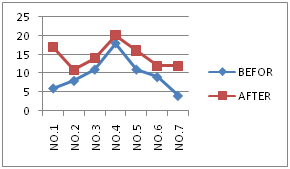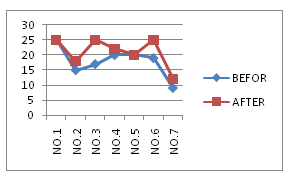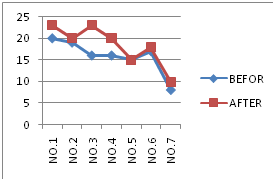Advances in
eISSN: 2377-4290


Research Article Volume 2 Issue 4
1Department of optometry University of medical Science Iran
2Iranian Federation of sport Iran
Correspondence: Sepideh Karimian optometrist University of medical Science Tehran Iran, Tel 09123403702
Received: January 17, 2015 | Published: May 25, 2015
Citation: Karimian S, Aghanasir F, Ebrahim JP, et al. Badminton player’s skills improvement after visual training. Adv Ophthalmol Vis Syst. 2015;2(4):119-123 DOI: 10.15406/aovs.2015.02.00052
In this study we try to show the effect of visual training on professional badminton player’s skills.
Keywords: badminton, visual skills, hand eye coordination, facility of accommodation, facility of vergence
There can be no doubt that that athlete’s visual skills (good or bad) have a significant impact (positive or negative) on their performance. Optometrist have demonstrated that visual skills like all physical skills can be taught, trained, practiced and perfected.1-5 We are not talking about having clear vision, which is very important, but also about improving dynamic visual acuity, eye focusing and teaming skills, visual spatial perception, and visual processing speed, visual reacting and response, Hand-eye coordination and peripheral awareness.6-9 Most players are similar in size ,speed and conditioning and all learn basic technique, but we have found one of the critical differences between athletes are their visual skills and visual abilities .it have proven in many researches and we can find it in many articles. Chances are that every athlete can improve in one or more visual skills area, i.e. dynamic visual acuity, visual recognition skills, depth perception, tracking or focusing abilities or even eye sight. Vision is the key of victory in all sports and vision performance exercises will become an integral part of athletic training in the near future.10-12
Badminton is a multidisciplinary skill. A successful player need good physical fitness .but, hand eye coordination (HEC) and visual skills may be very useful for players. In our study, the eye works performance program has been designed to provide visual skills assessments and training for all athletes. Using the eye works testing protocol; each athlete’s visual motors skills and sport skills are measured and recorded. We had chosen 40 badminton players and train them for 10 sessions and every session had take 40 minutes .But because their differentiation of their skills and level of their sport, we focused on professional athletes who had similar sport levels and sport skills.13-16 In this study we try to show the effect of visual training on professional badminton players `skills. We have decided to focus on trainings which are affected on facility of vergence and facility of accommodation and hand eye coordination.
Seven female badminton players that have play badminton for at least 5 years participated in this study. Routine and basic ocular and eye examination was done for every subject. Vergences and accommodation facility and hand-eye coordination (HEC) was recorded for every subject at the beginning of this study. Specific training for development of vergences and accommodation facility and HEC was done for all subjects. Vergences and accommodation facility and HEC have been measured and trained for ten sessions (Charts 1−8).

Chart 1 Visual skills and performances have shown by these charts: In these charts, Vertical lines show the scores and Horizontal lines show the athletes HCE, OD, Hand-eye coordination before training (blue line) and after training (red line) in right eye.

Chart 2 OS, Hand-eye coordination before training (blue line) and after training (red line) in left eye.

Chart 3 OU, Hand-eye coordination before training (blue line) and after training (red line) in both eyes.

Chart 4 Facility of Vergences. FAR, Facility of vergences at far before training (blue line) and after training (red line).

Chart 5 Near, Facility of vergences at near before training (blue line) and after training (red line).

Chart 6 Accommodation Facilities. OD, Accommodation Facility in right eye before training (blue line) and after training (red line).

Chart 7 OS, Accommodation Facility in left eye before training (blue line) and after training (red line).

Chart 8 OU, Accommodation Facility in both eyes before training (blue line) and after training (red line).
Two badminton coaches separately evaluate the players ‘s skills .these skills include right and left drop, net and toss’’.
We focused on these visual skills:
And then we tried to exercise some of these skills by using these practices:
The test result indicates that training could benefit the athlete’s. It means our sport vision training program is developed to strengthen and enhanced the individual motor skills. We discuss our recommendation with athletes and their coaches and we measured their sport skills with collaboration with their professional coaches. The results show there is a significant (p<0.05) improvement in badminton players skills after visual trainings. The number of fouls in “right and left drop, net and toss” significantly (p<0.05) decreased after vergences and accommodation facility and HEC trainings (Table 1−7). Visual skills and performances (vergences and accommodation facility and HEC) show significantly (p<0.001) than sport skills.
Athlete no.1 |
Before training |
After training |
||
Right hits |
Fouls |
Right hit |
Fouls |
|
Right Drop |
20 |
10 |
25 |
5 |
Left Drop |
23 |
7 |
22 |
8 |
Net |
18 |
12 |
18 |
12 |
Toss |
30 |
5 |
33 |
2 |
Table 1 HEC training No. 1
Athlete no.2 |
Before training |
After training |
||
Right hits |
Fouls |
Right hit |
Fouls |
|
Right Drop |
25 |
5 |
30 |
0 |
Left Drop |
24 |
6 |
28 |
2 |
Net |
22 |
8 |
25 |
5 |
Toss |
30 |
5 |
31 |
4 |
Table 2 HEC training No. 2
Athlete no.3 |
Before training |
After training |
||
Right hits |
Fouls |
Right hit |
Fouls |
|
Right Drop |
22 |
8 |
26 |
4 |
Left Drop |
20 |
10 |
23 |
7 |
Net |
20 |
10 |
21 |
9 |
Toss |
30 |
5 |
33 |
2 |
Table 3 HEC training No. 3
Athlete NO.4 |
Before training |
After training |
||
Right hits |
Fouls |
Right hit |
Fouls |
|
Right Drop |
22 |
8 |
25 |
5 |
Left Drop |
23 |
7 |
24 |
6 |
Net |
22 |
8 |
26 |
4 |
Toss |
29 |
6 |
33 |
2 |
Table 4 HEC training No. 4
Athlete no.5 |
Before training |
After training |
||
|---|---|---|---|---|
Right hits |
Fouls |
Right hit |
Fouls |
|
Right Drop |
22 |
8 |
28 |
2 |
Left Drop |
24 |
6 |
25 |
5 |
Net |
22 |
8 |
24 |
6 |
Toss |
32 |
3 |
33 |
2 |
Table 5 HEC training No. 5
Athlete no. 6 |
Before training |
After training |
||
Right hits |
Fouls |
Right hit |
Fouls |
|
Right Drop |
23 |
7 |
25 |
5 |
Left Drop |
26 |
4 |
26 |
4 |
Net |
22 |
8 |
24 |
6 |
Toss |
32 |
3 |
33 |
2 |
Table 6 HEC training No. 6
Athlete no.7 |
Before training |
After training |
||
|---|---|---|---|---|
Right hits |
Fouls |
Right hit |
Fouls |
|
Right Drop |
21 |
9 |
23 |
7 |
Left Drop |
22 |
8 |
23 |
7 |
Net |
20 |
10 |
24 |
6 |
Toss |
29 |
6 |
31 |
4 |
Table 7 HEC training No. 7
Ocular accommodation and fusional vergences were improved more rapidly and prominently after visual training. Sport performances showed slower, but, significant (P<0.05) changes after visual trainings. It seems, sport activities are more complicated than visual tasks. Improvement in visual performances may be so critical for badminton players. A developed visual system may provide faster, more accurate and enough spatial and temporal information. This information may help the players to predict, estimate and judge the shuttlecock, racquet, net, court layout and opponent player. Therefore, HEC and visual training may be useful for badminton players. Evaluation of visual skills may be a powerful tool for talent finding or improving the sport skills of any players (Table 8). The professional athletes in the high-speed sport which demand superior skills in balance, precision and perception have exceptional visual prowess. Sport vision offers training techniques to help achieve the alpha brain pattern characteristic of achieving “focus” or “in zone “facilitating sporting excellence. Visual rehearsal program together with Bio-Feed Back Mechanism pushes Sport vision beyond simple mechanism (Table 9). We have proven that visual skills increased by visual trainings and it affected on sport skills directly, but in high speed sports like badminton, some other special skills may affected on our results, some skills like the ability of “prediction” which is a complicated brain skills in an athlete that help him or her to predict the place of shuttlecock in every hit which has send to him or her, without even seeing it. These special abilities can be increased by practicing just like visual skills and affected on sport skills too (Table 10).
Athlete |
HCE |
Vergence Facility |
Accommodation Facility |
||||||||||||||
Before |
After |
Before |
After |
Before |
After |
||||||||||||
OD |
OS |
OU |
OD |
OS |
OU |
NEAR |
FAR |
NEAR |
FAR |
OD |
OS |
OU |
OD |
OS |
OU |
||
Athlete 1 |
75 |
72 |
88 |
85 |
82 |
92 |
6 |
11 |
17 |
19 |
25 |
25 |
20 |
25 |
26 |
23 |
|
Athlete 2 |
60 |
66 |
77 |
70 |
75 |
80 |
8 |
6 |
11 |
20 |
15 |
17 |
19 |
18 |
23 |
20 |
|
Athlete 3 |
73 |
70 |
85 |
89 |
81 |
102 |
11 |
15 |
14 |
15 |
17 |
22 |
16 |
25 |
22 |
23 |
|
Athlete 4 |
77 |
71 |
80 |
80 |
81 |
85 |
18 |
20 |
20 |
22 |
20 |
21 |
16 |
22 |
24 |
20 |
|
Athlete 5 |
80 |
74 |
90 |
95 |
77 |
100 |
11 |
12 |
16 |
16 |
20 |
18 |
15 |
20 |
20 |
15 |
|
Athlete 6 |
71 |
71 |
90 |
95 |
80 |
93 |
9 |
5 |
12 |
13 |
19 |
16 |
17 |
25 |
23 |
18 |
|
Athlete 7 |
60 |
70 |
83 |
85 |
90 |
96 |
4 |
9 |
12 |
12 |
9 |
11 |
8 |
12 |
12 |
10 |
|
Table 8 This table shows the scores of visual skills before and after training
Sessions |
Acc. facility |
Vergence facility |
HEC |
|
NO.1 |
OD:20/OS:18/OU:15 |
Near:12/Far:11 |
OD:80/OS:74/OU:90 |
|
NO.2 |
OD:12/OS:23/OU:18 |
Near:15/Far:15 |
OD:73/OS:70/OU:100 |
|
NO.3 |
OD:21/OS:23/OU:18 |
Near:8/Far:8 |
OD:91/OS:75/OU:115 |
|
NO.4 |
OD:18/OS:26/OU:18 |
Near:10/Far:8 |
OD:95/OS:77/OU:100 |
|
NO.5 |
OD:19/OS:24/OU:19 |
Near:10/Far:10 |
OD:100/OS:84/OU:100 |
|
NO.6 |
OD:19/OS:20/OU:18 |
Near:10/Far:10 |
OD:98/OS:90/OU:102 |
|
NO.7 |
OD:21/OS:23/OU:20 |
Near:12/Far:12 |
OD:99/OS:90/OU:108 |
|
NO.8 |
OD:21/OS:21/OU:19 |
Near:12/Far:10 |
OD:100/OS:90/OU:110 |
|
NO.9 |
OD:23/OS:22/OU:23 |
Near:16/Far:10 |
OD:100/OS:90/OU:114 |
|
NO.10 |
OD:23/OS:22/OU:23 |
Near:16/Far:11 |
OD:100/OS:90/OU:115 |
Table 9 These 2 tables are just for one of our athletes’. We have 14 tables like this
Sessions |
Right drop |
Left drop |
Net |
Toss |
NO.1 |
20 |
23 |
18 |
30 |
NO.2 |
23 |
17 |
20 |
33 |
NO.3 |
20 |
19 |
14 |
32 |
NO.4 |
24 |
25 |
15 |
32 |
NO.5 |
23 |
26 |
18 |
32 |
NO.6 |
24 |
20 |
18 |
33 |
NO.7 |
25 |
22 |
18 |
33 |
Table 10 Sport skills for athlete no.1
I appreciate the time and detail provided by each reviewer and by you and has incorporated the suggested changes into the manuscript to the best of my ability. The manuscript has certainly benefited from these insightful revision suggestions. I look forward to working with you and the reviewers to move this manuscript closer to publication in the “Advances in Ophthalmology & Visual System magazine”.
Author declares that there is no conflict of interest.

©2015 Karimian, et al. This is an open access article distributed under the terms of the, which permits unrestricted use, distribution, and build upon your work non-commercially.